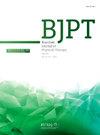Environmental factors contribute to the success of extubation in newborns: A multicenter cross-sectional study
IF 3.2
3区 医学
Q1 ORTHOPEDICS
引用次数: 0
Abstract
Introduction
Newborns (NB) undergoing invasive mechanical ventilation (IMV) should be extubated as early as possible. Predictive factors for successful extubation are often considered in isolation, focusing on personal factors and the functions and structures of the NB's body, according to the International Classification of Functioning, Disability and Health (ICF).
Objectives
To assess the contribution of ICF components to the successful extubation of NB.
Method
A multicenter, observational and retrospective study was conducted using medical records of NB from five macroregions of Brazil. NB who underwent IMV of >24 h were included. Clinical and sociodemographic variables were organized according to ICF components, and factors associated with successful extubation were analyzed using a generalized linear model.
Results
A total of 498 NB were included, with an extubation success rate of 82.3 %. The body functions and structures component included pH (p = 0.006), the environmental factors component included the number of prenatal consultations (p = 0.002) and mode of ventilation (p = 0.004), and the personal factors component included gestational age (p < 0.001), birth weight (p < 0.001), gestational age at extubation (p < 0.001), and weight at extubation (p < 0.001). Environmental factors increased the probability of successful extubation by 1.72 times (95 % CI: 1.26, 2.35).
Conclusion
The environmental factors component of the ICF significantly influenced extubation outcomes in NB, increasing the probability of success. These findings highlight the importance of developing extubation protocols that integrate predictive variables from all ICF components, considering both functional and structural alterations along with contextual factors.
环境因素有助于新生儿拔管成功:一项多中心横断面研究
新生儿进行有创机械通气(IMV)时应尽早拔管。根据《国际功能、残疾和健康分类》(ICF),通常孤立地考虑成功拔管的预测因素,侧重于个人因素以及新生儿身体的功能和结构。目的评价ICF成分对NB成功拔管的作用。方法采用多中心、观察性和回顾性研究方法,对巴西5个大区的NB病例进行分析。纳入接受IMV治疗24小时的NB。根据ICF组成部分组织临床和社会人口学变量,并使用广义线性模型分析与拔管成功相关的因素。结果共纳入NB 498例,拔管成功率为82.3%。身体功能和结构因素包括pH值(p = 0.006),环境因素包括产前咨询次数(p = 0.002)和通气方式(p = 0.004),个人因素包括胎龄(p <;0.001),出生体重(p <;0.001),拔管时胎龄(p <;0.001),拔管时体重(p <;0.001)。环境因素使拔管成功率提高1.72倍(95% CI: 1.26, 2.35)。结论ICF的环境因素对NB拔管结果有显著影响,增加了拔管成功率。这些发现强调了制定拔管方案的重要性,该方案整合了所有ICF组件的预测变量,同时考虑了功能和结构变化以及环境因素。
本文章由计算机程序翻译,如有差异,请以英文原文为准。
求助全文
约1分钟内获得全文
求助全文
来源期刊
CiteScore
6.10
自引率
8.80%
发文量
53
审稿时长
74 days
期刊介绍:
The Brazilian Journal of Physical Therapy (BJPT) is the official publication of the Brazilian Society of Physical Therapy Research and Graduate Studies (ABRAPG-Ft). It publishes original research articles on topics related to the areas of physical therapy and rehabilitation sciences, including clinical, basic or applied studies on the assessment, prevention, and treatment of movement disorders.

 求助内容:
求助内容: 应助结果提醒方式:
应助结果提醒方式:


